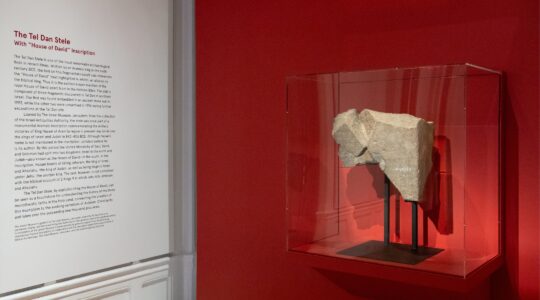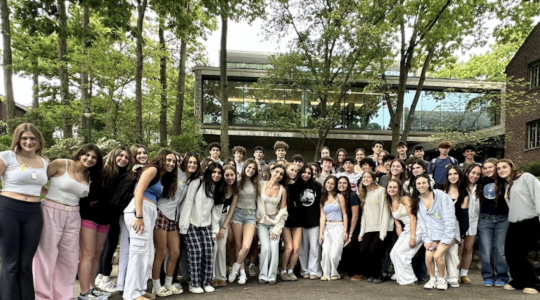My grandparents came from Grodno. That’s what I learned from my mother and aunt while growing up. My grandfather, who died on his synagogue steps in Buffalo two years before I was born, and my grandmother, who died the spring before I entered college, had been born and raised in the city in the Polish-Russian-Lithuanian Pale of Settlement that we collectively knew as the Old Country.
They came, according to family legend, early in the 20th century.
Actually, I would learn eventually, they came from Grodno Gubernia: the Grodno territorial unit in the old Russian empire. That’s like saying someone’s from the 2nd District of the U.S. Federal Court. Not very specific. Each gubernia contained dozens of towns and villages: the fabled shtetlach.
I heard stories, from Mom and Aunt Henny, about my grandparents’ shtetl life, about Zorach (I’m named for him; Hebrew name Zerach) Finklestein selling milk from the cow they kept in their yard, about his wife, Goldie (my niece, Julianne, is named in her memory) beating the clothes clean at river’s edge against a serrated board, about their voyage across the Atlantic, about their arrival at Ellis Island.
From Grandma, who lived upstairs from us, I learned none of this. She spoke only Yiddish and a smattering of Polish. How we communicated, I don’t remember.
We never heard details about pre-America days. My grandparents’ generation didn’t talk about the life they escaped, and my parents’ generation didn’t ask.
My generation wants to know. Who were our grandparents? How long had they lived in their Eastern European communities? How had they lived?
Thank God for the Internet.
I embarked on a family roots search a few years ago, going on-line, reading old documents my grandparents had serendipitously saved. I found a name, Copetken, on some immigration forms as Zorach and Goldie’s original home.
I checked a map of Belarus, the former Soviet republic where Grodno is now located. About 12 miles northwest of Grodno, in a northwest corner of the country, near the Polish border to the west and the Lithuanian border to the north, is a village named Sopotskin.
It’s the only match in the area. Different sources offer a score of different spellings, a transliteration from the Cyrillic. It’s where my grandparents came from, I determined, in May 1904.
Sopotskin was a typical shtetl, I would learn, full of tailors and fish sellers and grocers.
Support the New York Jewish Week
Our nonprofit newsroom depends on readers like you. Make a donation now to support independent Jewish journalism in New York.
More research, interviews with old relatives and correspondence with landsmanshaften told me more about a farming village of a few thousand people, mostly Jews; about a community with a central square from which several streets branched out; about a rural Jewish life punctuated by pogroms and ended by the Holocaust.
I had more questions. What happened to the mishpocha my grandparents had left behind? Had any of Sopotskin’s Finklesteins or Cohens survived the Shoah? Did I have some relatives still living somewhere over there?
Last month I went over there.
Supported by the American Jewish Joint Distribution Committee, I volunteered to help lead Passover seders in Grodno; the 1,500-member Jewish community, still reeling from decades under atheistic communism, lacks the knowledge to conduct their own festival meals.
The morning after Passover, I headed to Sopotskin. The JDC had arranged permission: Sopotskin, near the borders, lies in a restricted military zone. The government asked for relatives’ names, for addresses and places of work, for other background facts. Nobody in uniform, it turned out, stopped our van on the half-hour drive through rolling fields and birch forests.
Accompanied by a driver provided by the local Chesed organization; Tatiana Novikova, an interpreter who often works for Jewish organizations; and Haim Shapiro, a pensioner Grodno Jew whom I’d met in shul and who offered to show me the way, we went up and down the streets of Sopotskin. Haim, a retired builder, had worked in Sopotskin.
I already knew that no Jews had returned there after World War II. I knew the three synagogues had burned down. I knew that the Jewish cemetery was in disarray. Maybe, I hoped, I would find someone who remembered a member of my family. Maybe I would find a gravestone with a relative’s name on it.
For what I was looking I didn’t know specifically beyond a connection to kin I largely hadn’t known or known about.
Haim hopped out of the van and walked into a two-story building, a skyscraper by Sopotskin terms. He returned a few minutes later waving for us to follow him into the building. He introduced us to Rusina Yevgeniya Petrovna, a middle-aged regional administrator who works in Sopotskin’s unheated municipal hall. She offered to show us around.
Petrovna introduced us on the street to an 86-year-old woman, one of the village’s oldest residents. Leaning against a fence, speaking with the Polish accent common among the people of Sopotskin, the old woman shared her memories of the Jews she had known while growing up there. They had gone to school together.
"They were good people," she said, giving the thumbs-up sign.
She recalled the Jews had brought her Christian family matzah on Passover. She didn’t remember any names.
Support the New York Jewish Week
Our nonprofit newsroom depends on readers like you. Make a donation now to support independent Jewish journalism in New York.
Yadya Kolvinskaya, another old woman, had her memories, too. Kolvinskaya showed us where a synagogue, now gone, and a Jewish school, long destroyed, had stood. She told about sharing a piece of bread with a young Jewish boy during the Nazi occupation.
"The Germans beat me," she said. "They were on the street."
Kolvinskaya also did not remember the names of any Jews.The village, population now 1,400, hasn’t changed much from the old pictures I had found. The village square, once the central market area, has given way to a park with the di rigueur war memorial. The dirt roads are covered with asphalt. The houses (some of the wooden shacks, at least) look like they haven’t been repaired in a century. Now, however, they are connected to electric poles; there are TV antennas throughout the village.
The small house at what had been 7 Assotchiniki St. was of special interest. That, my research had determined, was where one Yaacov Finklestein had lived. No one in my family could identify him, but his was the only Finklestein listed in Sopotskin at the turn of the last century, so that must have been my grandparents’ home.
The street of my Orthodox forebears, which was named for Lenin during the communist era, now bears the name of Pope John Paul II.
From the outside, the house looks big enough for only a few rooms. The wooden planks are rotted. A few chickens wander in the yard. The house was deserted but the gate was locked, so we couldn’t go inside.
Was this the right address, or had the street numbers changed over the years? Was this the house my grandparents had lived in, or had theirs burned down years ago?
More questions at the cemetery. Were any of my family members buried there? The cemetery, located on a rutted hill a hundred yards behind the municipal hall, was separated by a lawn where a few goats were tethered. Like most Jewish burial grounds in that part of the world, it was deserted and neglected: broken gravestones, the words on them worn away and nearly impossible to read, lie in pieces and jut out of the earth. Dartmouth College students who come as volunteers each summer to renovate the site provide its only care.
I had been warned that I wouldn’t find any Finklestein or Cohen matzevos. I didn’t.
More questions in the regional high school’s small museum. Tadeusz Lukuc, a fortyish teacher who doubles as an archivist, showed us around the single-room display of old photos, wartime helmets and native embroidery. A few panels were devoted to Sopotskin’s former Jewish community.
"The Jews helped make Sopotskin," Lukuc explained.
Some tattered pages that inexplicably had turned blue caught my eye. Loosely bound together, the dozen or so sheets of paper were in Hebrew. Someone had told Lukuc they were from a Jewish prayerbook. His friend was wrong. They were from an old Chumash, from the Book of Exodus, from the portions of Tetzaveh and Ki Tisa. Alongside the text were Rashi’s commentaries and lines in Yiddish.
Support the New York Jewish Week
Our nonprofit newsroom depends on readers like you. Make a donation now to support independent Jewish journalism in New York.
The pages had been found in someone’s attic, Lukuc said. Had earlier inhabitants of the Sopotskin building saved the Holy Scriptures from destruction or used them for insulation? Lukuc didn’t say.
Had my grandfather ever held these pages?
Nobody could say.
I had to have some of the pages. I offered Lukuc $20; take your pick, he said.I chose two crumbling pages at the bottom of the pack. They were cracked, with watermarks or burn marks at the edges. I’m leaving you the best pages, I told Lukuc.
The pages are going on my wall, framed, with a little stone I picked up from the streets of Sopotskin. They are going on my eastern wall, next to pictures of the Western Wall. When I face mizrach to daven, as my grandfather did, they are a reminder that more than stories, more than names on a gravestone, I had what found what I was searching for: pieces of the Torah that connected his generation with mine.
The New York Jewish Week brings you the stories behind the headlines, keeping you connected to Jewish life in New York. Help sustain the reporting you trust by donating today.




